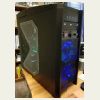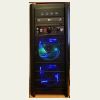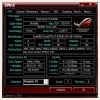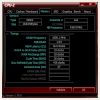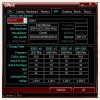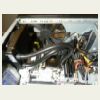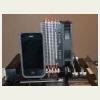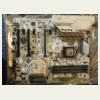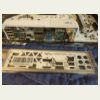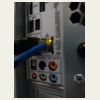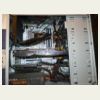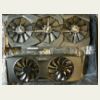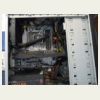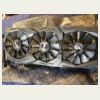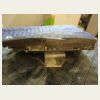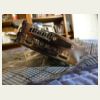2017 (November) Build
2017 (November) Build2017 (November) Computer Build
Since I tend to purchase partial upgrades over time, I'll put down the dates that I bought each component as well as the price I paid at that time. As time goes on, those prices tend to drop, so you could probably pick up the exact rig I have for less than what's listed below or create a better one for the same amount. That's just the way it is with computers. Last July I pretty much did do a full upgrade including a new motherboard, CPU, GPU, memory, and CPU cooler. I wanted a rig that was guaranteed to handle any VR headset (which I still don't own). That meant a new GPU in the form of a GTX 1080 (though the GTX 980 I had probably could have done the job). But then, my CPU just hit four years old, so it was due for an upgrade, which meant a new motherboard, which meant new memory, which in turn meant a new CPU cooler. (Technically, I could have used the old cooler, but that CPU, motherboard, memory, and cooler went to a new home.)
I upgraded from an Intel Core i7 3770K to an Intel Core i7 6700K. I also opted for all-in-one water cooling, so I overclocked the CPU from 4.0GHz to 4.5GHz. I know I don't "need" the i7's extra threads for gaming versus the Core i5 6600K, but I wanted them anyway. (Not everything I do is gaming.) I also don't "need" the extra speed for the games I have, but the AIO water cooling keeps the CPU at such a low temperature that I feel comfortable leaving it there.
I bought this CPU at Micro Center in July of 2016 for $310, whereas I bought the 3770K in July of 2012 for $290. (With the introduction of the 6800K, the price of the 6700K has dropped to $260 as of November 2016.) In the past, I'd be looking for a new CPU way before a four-year run, but I didn't have any issues running the latest games. However, I knew it was going to be a bottleneck with the new GPU. The Intel 6700K uses an LGA 1151 socket as opposed to the 3770K's an LGA 1155 socket, so that meant I needed a new motherboard, too. As for the last two or so CPU upgrades I have purchased, I got them at my local Micro Center. The CPU was about $50 cheaper than Newegg or Amazon. The catch is that it is in-store only. Luckily, my nearest store is about 20 minutes from where I work. To sweeten up the deal a bit, they had (and almost always have) an additional $30-40 off when purchasing a motherboard combo.
About seven years ago, I chose a dual-core processor with a faster clock speed over a quad-core processor because games at the time did not make good use of the extra cores. I attended an online seminar where I got confirmation of that from an Intel person that I'll paraphrase here:
"At the Intel Core i7 and Corei5 Launch webcast that Newegg and Intel hosted, I asked the following question: Are game developers starting to take advantage of the dual and quad-core processors? A manager on the Intel extreme motherboard team said that she was a gamer, too, but she was not seeing the developers make use of the multiple cores/threads yet."
Times have changed. Now, some games perform poorly on CPUs with two or fewer cores because they are dependent on the hyperthreading capability to maintain high frame rates. Coupled with things like Intel's Turbo Boost, having at least four cores is probably the sweet spot at the moment. Going beyond a quad-core is probably still overkill, but there are games out now using up to eight cores (and a couple using more). DirectX12 itself encourages the use of more cores, too (up to about eight, where it currently seems to drop off a bit). There are articles from time to time that talk about PC game performance, but a good site that appears to measure a good number of games in a consistent manner is the Dark Side of Gaming: PC Performance Analysis section. They don't cover all new games for sure, but they hit many of them and games that span a number of gaming engines. They tend to avoid games that are anticipated to run well on just about any modern system.
I decided to try an all-in-one (AIO) CPU water cooler. I could have gotten a Cooler Master Hyper 212 EVO, but I planned to overclock the CPU from day one. Because my case wasn't made to support a dual-fan radiator (in fact, water cooling at all was rare when I got this case), I went with a single-fan Corsair Hydro Series H60.
Compared to the heft of the Hyper 212 Plus it replaced, the H60 is downright diminutive. The picture on the left above is the H60, and the one on the right is the Hyper 212 Plus (shown with an iPhone 4 as a size reference). I didn't realize just how much space the 212 took. I'm sure the H60 helps airflow as well as being a better overall CPU cooler. One difference when building this system is that I put the CPU, cooler, and memory on the motherboard before installing it into the case. With the radiator/fan assembly of the H60, that's not practical. So I installed the H60's backplate before putting the motherboard in the case and installed the cooler (technically, the "cold plate") and radiator/fan afterward. I also removed the existing rear 120mm case fan and used the H60's radiator/fan in its place.
I'd been so happy with the Asus Sabertooth Z77 motherboard that I used with the 3770K that I went with the Asus TUF Sabertooth Z170S for this build. See the thumbnail below. It was purchased as a bundle with the CPU in July 2016 from Micro Center for $158, including a $30 bundle discount. (So it was regularly $188.) This motherboard has six SATA 6.0Gb/s and/or two SATA Express connections (that would overlay four of the six SATA connections if both were used), one M.2 socket (2242 through 22110 with PCIe mode), six USB 3.0 ports (two on the back and four motherboard headers), eight USB 2.0 ports (four on the back and four headers on the motherboard), a single USB 3.1 port, a decent audio chip with shielding and a separate layer (which I don't use). There are four DDR4 memory slots supporting up to 64GB of RAM and XMP profiles up to 3200MHz. There are two PCI Express 3.0 x16 slots for graphics or other expansion cards (of which I use one in x16 mode as opposed to two graphics cards in x8 mode) and one PCI Express x16 slot that supports up to x4 mode. Additionally, there are three PCI Express x1 slots.
I had a few issues with the I/O shield during installation, which is a bit unusual. That's usually an innocuous part. First, remove the TUF LANGuard sticker over the Ethernet port before building (as shown in the second image above). I saw that sticker and realized it would be a PITA to get off after installing the motherboard. One potential issue was avoided.
It's not visible in the picture, but the I/O shield is backed with a thin foam layer covered with conductive foil. It's a nice alternative to the metal grounding "fingers" most I/O shields use (that can get stuck into various ports when the board is inserted). However, the lower-left corner of the foam got folded over when I inserted the motherboard - covering a couple of the USB 2.0 ports. I could have fixed that with a razor knife, but I ended up fixing it the "right way" by taking the motherboard partially back out and straightening out the foam. That added an hour to the build that wasn't necessary.
However, the I/O shield wasn't done being a pain. When I went to plug in my Ethernet cable, it wouldn't stay in. There's a tab in the shield that surrounds the Ethernet port that sticks up enough to depress the Ethernet cable's release tab. I have no idea what possessed the designer to put that tab there. I fixed the problem with an "end-user modification" involving needle-nose pliers. (See the third picture above.) The final picture in this series is the "as-built" view of the motherboard with all the parts installed.
This motherboard supports very fine-grained tuning for overclocking, and I intended to overclock from day one. The auto-overclock similar to earlier boards was still available, but I found manual overclocking to be more beneficial. I am running the CPU at 4.5GHz as opposed to the stock at 4.0GHz. I could probably get more, but this is stable and seems to be sufficient.
I had already recently splurged big time on a new GTX 980 graphics card. However, I wasn't convinced it would handle a VR headset (assuming I buy one shortly). I was lucky enough to snag an ASUS GeForce GTX 1080 8GB ROG STRIX OC Edition Graphic Card (STRIX-GTX1080-O8G-GAMING) in July 2016 for an outrageous (for me, anyway) $680 from Amazon. The supply chain isn't quite as constrained as it was when I got this one. I discovered (and credit) NowInStock.net for getting it then at all. I set it up to notify me when it was in stock, which it did. It was sold out by Amazon less than 10 minutes later.
One word of caution to others: this card is really, really big. In the first picture below, I laid the Asus GTX 1080 next to the EVGA GTX 980. It's probably an inch and a half longer than the 980. The precise dimensions at Asus are 11.73" long x 5.28" high x 1.57" thick. In the second picture, you might be able to see that to get this card to fit, and I had to move the drive cages one notch farther out. It doesn't look bad, but it's the absolute maximum-size graphics card that I could get in this case. The third and fourth pictures show the front (cooler), and top views and the final image is of the video ports supplied by this card. Unlike other manufacturers, Asus has two HDMI 2.0 ports and two Display Port sockets (as opposed to one and three of the same, respectively). The two HDMI ports are to support VR headsets.
The rule of thumb I usually impart to others is that when building a mid-range gaming system, expect to pay from 100% to 130% of the cost of the CPU on the video card. This rule holds pretty well. This time, I didn't listen to myself. You see, I had been lusting after the 2560x1440 pixel resolution (aka 1440p) ever since those cheap Korean panels started showing up on eBay. At one point, I was on my way to Micro Center to buy one of them. I was listening to a Maximum PC podcast during the drive, and a listener asked the question if an Nvidia GTX 670 was good enough to drive one of the monitors. The response was, "Oh, hell, no." That's the exact graphics card I had at the time; I drove right on past.
Driving that number of pixels takes a serious high-end card. The kind of high-end card I never seemed to be able to bring myself to lay out the cash on. Now that I have it, let me say that gaming at 2560 x 1440 is very, very nice. If you can swing it, I highly recommend it. The GTX 1080 was 234% of the cost of the CPU. I bought an EVGA GTX 980 SC in December 2014 for $560, but when I heard the statistics for the new 1080s, I was sure that's where I needed to be for full-out 1440p gaming and VR. I'm a very bad person. But I am a very happy gamer.
While I lusted after the Korean 2560 x 1440 monitors, I never pulled the trigger on buying one. However, when I was throwing lots of cash at the video card, I also got a Dell U2713HM 27" Widescreen LED Backlit LCD Monitor from B&H Photo Video for $518 in December 2014. Yep. Paid less for the monitor than I spent on the (original GTX 980) video card to drive it. My previous monitor was also a Dell, and it always worked well. (Still does, in fact. That monitor developed a mysterious "tear" where a three-inch high and 1/4-inch wide vertical line just stopped working. I never figured out why.) I upped my resolution from 1920 x 1200 to 2560x1440 (WQHD), changed from a fluorescent to LED-backlit, and changed from a TN panel to an IPS panel. What a tremendous difference. I think that model has now been replaced with the Dell U2715H.
To go with the new motherboard, I needed new DDR4 memory. The motherboard supports XMP up to DDR4-3200, so the memory I went with was 16GB (2 x 8GB) of Corsair Vengeance LPX DDR4-3200 (PC4-25600) (CMK16GX4M2B3200C16) for $87 also from Micro Center. I used a similar Corsair Vengence memory kit with my last motherboard with really good results. For me, getting this to work at 3200 MHz consisted of setting the XMP profile in the BIOS and rebooting. That's it.
I still have two of the four slots on the motherboard open, so I could bump up to 32GB or 48GB of RAM (or 64 GB if I replace this 16 GB) if I ever need it. I didn't even need 16 GB as the games I played seemed to be happy with just 8 GB. However, I don't have to worry about having a browser or other apps open when I play games.
For over a decade, I was a proponent of using the motherboard's onboard RAID controller to set up RAID 0, RAID 1, or even RAID 0+1. There was a "dark period" when the reliability of the major manufacturer's hard disks seemed to go into the toilet. Having mirrored drives (RAID 1) saved my bacon more than once. But the speed of striped drives (RAID 0) is very appealing to gaming. I went with a four-drive configuration that combined the two (RAID 0+1). When hard drives are a bit flakey, stick four of them in your rig. Well, let's just say I got good at swapping drives. It's all good, now. I don't use any form of RAID anymore. Why? SSDs.
Along with a new motherboard, I bought a pair of Samsung 830 2.5" 256 GB (MZ-7PC256N/AM) SSDs in July 2012 from Amazon for $240 each. I was waiting for the price to drop below $1 per GB, and it happened. One drive would be dedicated as the boot drive, user files, and the basic apps like the Microsoft Office suite. The other would be dedicated to games - mostly a big Steam folder. I expected the difference to be dramatic. I underestimated it. I was blown away. From cold power on to the Windows login prompt, it now takes less than 30 seconds. If I discount the time for the motherboard to POST, it's about 20 seconds. Game levels load so fast that I don't get time to read the tips. I used to dread Windows updates - especially if there was a .NET update. Now, if I have a few minutes to spare, I've got time for the update. I will never build another system where the primary boot drive isn't an SSD. Period.
Many cases available today have mounts for 2.5" SSDs. My case doesn't have that, so I bought a SilverStone Technology 3.5-inch to 2 X 2.5-inch Internal Hard Drive HDD / SSD Bay Converter, Silver (SDP08) converter to mount both drives in a single 3.5" internal slot. I had to mount one of the drives upside down so that the cables didn't interfere with each other. Since SSDs have no moving parts, that's not a concern.
In November 2013, I upgraded the game SSD to a 500GB Samsung 840 EVO (MZ-7TE500BW) I bought from Newegg for $285. I know that spec-wise, the 840 is faster than the 830 was, but I can't tell the difference. I just needed more space. The exciting part was that just a little over a year later, I doubled the space for a price not too far from the same as the 256 GBs. The price just keeps on coming down. The 500 GB 850 EVO that replaced my 840 EVO is now $180 (i.e., over $100 less). I still recommend getting the largest capacity you can afford. An interesting characteristic of SSDs is as the capacity increases, the drive tends to get faster since the SSD's read memory in parallel "channels." The bigger the capacity, the more channels.
I regularly use the Newegg app on my Android phone to check the daily specials, which Newegg calls "Shell Shockers." In addition to the same specials everyone sees on the website, the app also has from zero to five "Mobile Exclusive" specials. In January 2016, one of those was the 1TB Samsung 850 EVO (MZ-75E1T0B/AM) for $289 shipped. That was $41 bucks off the price at the time, and I snatched one while cackling evilly. Just a month later (February 2016), the regular price was $295 at both Newegg and Amazon. I figured I just got out a little ahead of falling prices. It turns out that was wrong, as the NAND memory shortage drove prices back up.
I switched to the 500GB 840 EVO as my boot drive and the 1TB 850 EVO as my games drive. Note that it took two years (instead of one year) for the price of the 1TB 850 EVO drive to fall to the same price I paid for the 500GB 840 EVO drive. Now, I'm at 1.5 TB of SSD storage (and 4TB of regular HDD storage - next paragraph).
In addition to the SSDs, I recently updated to a single 4TB Western Digital Black (WD4004FZWX - SATA 6Gb/s) (partitioned into two 2TB partitions). That drive replaced a pair of Western Digital Black WD1001FALS 1TB drives (SATA 3 Gb/s) interface purchased in 2011. They were a year past their five-year warranty, and though I'd never had a single issue with them, they were making me nervous. I purchased the new drive from Amazon for $190 in November 2017. I don't use it as a game drive, but I have been putting more and more videos and pictures on there. I also use SteamTool to offload games I have finished (but I'm not quite ready to uninstall) onto one of the two partitions (which appear as two drives).
While the sound quality of motherboards has improved, I still prefer a dedicated sound card. I'm currently using a Creative PCI Express Sound Blaster X-Fi Titanium Fatal1ty Champion sound card that I bought from Newegg for $105 in October 2011. It has a separate break-out box that fits into an external 5-1/4" slot. I still like being able to control the effects and volume with real knobs and buttons. It's a control thing. This version uses a PCI Express x1 slot.
My speakers are ancient by any standards. I have had Klipsch 4.1 Promedia surround sound speakers since about 1999. I just about bought another speaker system because both subwoofer speakers had just rotted out with age. Someone clued me in that Klipsch sells replacement parts, and I took advantage of that. It's still going, and with the repair mentioned above, sounds great. I paid $400 for these (as part of a system from Falcon Northwest - the only gaming system I ever bought instead of made myself). The replacement speakers were something like $60. They can put out way more than the volume needed to enjoy any game, video, or audio. The volume knob is starting to go, but I'll hold onto these as long as I can. I'd buy another set of these exact speakers, but Klipsch stopped making the four-speaker version years ago. They still have the two-speaker version for sale.
I've had more headsets than I care to recall. My current one is the Kingston HyperX Cloud Gaming Headset (KHX-H3CLW) - the white one. I'm not sure I can recommend these highly enough. They weren't super cheap at $70 (on sale) from Amazon, but they sound better than headsets for which I paid more. They are comfortable for hours, too. That's what the "cloud" part is. It's like putting a comfy cloud over my ears. At least, they stay on my head without putting it into a vise. The mic is detachable, and I leave it off when I don't need it. They come with every connection option I've ever seen. I can connect these to every device in my house (and my phone in my pocket) using one of the included adapters. They even have an airplane adapter (and come with a carrying pouch). Buy these.
I will take a moment here to bow my head and say a few kind, respectful words about my now-deceased OCZ GameXStream 700W (OCZ700GXSSLI) PSU. I purchased it in December 2006 from Newegg for $149. I used that same PSU for at least four different builds. I wrote in April 2015 that time is an enemy of PSUs, and I should probably think about replacing it soon. My "soon" was June 2015, when one morning, I awoke to the UPS complaining that one of the inputs to it was shorted out, which turned out to be the PSU inside my desktop. OCZ's PSUs were apparently pretty hit-and-miss as far as quality, but for me, working for 8-1/2 years in a high-demand gaming PC rig is pretty darn respectable.
OCZ bought PC Power & Cooling - a well-respected PSU maker, and I believe their expertise went into the OCZ PSU I had. I'd even consider buying a replacement PSU from OCZ, except they went bankrupt at the end of 2013. Their SSDs are still available for sale, but that part of OCZ is now a subsidiary of Toshiba. PC Power & Cooling was sold to and became FirePower Technology, Inc., and their PSUs are getting good reviews.
My (new) current PSU is the EVGA SuperNOVA 750W B2, which I purchased from Newegg for $75. EVGA doesn't make its own PSUs. These are made to EVGA's specifications by Fortron Source Power Group (FSP Group), which is a well-respected brand. This unit is "semi-modular," meaning that some of the cables are fixed and permanently connected to the unit. Others are optional and can be plugged into the PSU as needed (that's where the modular term comes in). The fixed cables are the 8-pin CPU connection, the 24-pin motherboard connection, and a pair of 6/8-pin GPU connectors. That's a pretty good guess. I used two of the three SATA power cables and one of the Peripheral (old 4-pin Molex power) cables. The latter exists solely to power case fans in the top and back.
I've recently become a fan of SeaSonic, Corsair, and EVGA's SuperNOVA line (made by Fortron/FSP) power supplies. Because I have at least three desktops in the house at any given time, I keep a spare PSU handy (as well as case fans of all sizes). That's why the purchase date of the EVGA SuperNOVA is May 2015. I'd actually purchased the exact model before that, but it went into a friend's gaming rig when he shorted his out. As my new backup to replace the EVGA B2, I've got an XFX Core Edition PRO850W coming from Newegg, which cost $90 but had a $30 rebate. (Normal price is $100.) Like EVGA, XFX doesn't manufacture the PSUs, and that PSU is made for XFX by Seasonic. There's a really handy list of who's who are PSU manufacturers at Tom's Hardware. Unfortunately, it tends to fall out of date. Still, it's a very good reference.
Interestingly, almost all of my recent system upgrades are faster but use less power than their predecessors. CPU - faster and uses less power; GPU - faster and uses the same power (I was already using a Kepler-based card when I moved to a Maxwell-based one and finally, a Pascal-based one - and really, I went from a GTX 670 to a GTX 980 and then a GTX 1080, so it would have been great just to break even.); disk drives - hugely faster and use less power. I also have fewer drives in my system. Overall, the load on the PSU is decreasing. (My UPS confirms this with the estimated runtime, which has gone up with every upgrade.)
My case is the second oldest part of my system (now that my old OCZ PSU died). It's an Antec Nine Hundred (the original version with USB 2.0 front ports rather than USB 3.0). I'm on the fourth build into the same case. That case has since been replaced by the Antec Nine Hundred Two V3. The flexibility of this case has always been fantastic. This case has lots of features that I like, including:
- Bottom-mounted power supply
- There are two removable drive cages (with independent cooling fans) that each can hold three drives. Without the drive cages, the case can hold even more. I tinker with my machine more often than most, and these drive cages make life much easier.
- Again, there are lots of that ever-important airflow and fans, including a huge top fan.
- Sides come off and go on very smoothly and easily.
At some point, I did have to replace both front 120 mm fans. That's it. I got this during one of Newegg's weekend sales for $99 and $10 shipping back in June of 2009. A similar case is still for sale, but the USB has been upgraded to USB 3.0. It's $95 from both Newegg and Amazon. Newegg has free 4-7 day shipping or $18 three-day shipping. (Three days was the cheapest option at the time I got mine.) If you are an Amazon Prime member, two-day shipping is free.
Since I spend so many hours at the keyboard between my job and my hobbies, I've been using an ergonomic keyboard for over 20 years. My first one was the Microsoft Natural keyboard, made in 1994. I was forced to use a Microsoft Natural Elite for a while (when I wore the first one out). The Microsoft Natural Pro came out in 1999, and to this day, I think the Microsoft Natural Pro is the best affordable ergonomic keyboard ever made. When I found out they were discontinuing them, I bought five. Unfortunately, gaming is hard on keyboards, and the WASD and left control (CTRL) keys eventually gave out on all. It took years to go through my stash, but I eventually did. Now, I use the Microsoft Ergonomic Keyboard 4000. These keyboards pale in comparison to the Microsoft Natural Pro, but they are decent and cheap (at around $30-50). I bought a 3-pack on sale from Newegg for $60 in August of 2014. I still wear them out regularly, but I don't feel as sorry about it.
I'd gladly put real money into an ergonomic keyboard with mechanical switches if anybody made one for a decent price. No, $250 isn't a decent price. No, $400 and $1,000 aren't decent prices either. It should be $200, tops - preferably $150. Somebody, get on this, please. Oh, and please make it look like a keyboard rather than something that belongs in a medical examination room.
I'm currently using a Logitech G602 Wireless Gaming Mouse that I purchased from Amazon for about $40 in January 2017. I used to use the Logitech G9X, and I liked it a little more because it was a bit wider. That's been discontinued and the remaining stock is astronomical in price (over $250). Prior to that I used the G502 is a pretty darn good mouse, but my major gripe was that they "improved" it and made it so that the weight was not adjustable (as it was on the Logitech G502 I had before). The G602 doesn't have weight adjustments either, however, since it's wireless and takes 2 AA batteries, it's still pretty heavy, which is the way I like them. One of the G602's features is on-the-fly dpi ranges. That is, you can set three different DPIs as the default onboard profiles. In addition, there is a thumb button that serves to "downshift" from a higher to lower DPI for things like precision sniping in first-person shooters. I believe the mouse software supports loading different DPIs for different games, but I really don't bother. The three onboard profiles do the job for me.
I'm a subscriber to the Microsoft Action Pack program. As such, I have access to just about every operating system version Microsoft supports, is actively selling, or is about to sell. Until mid-September, I used Windows 8.1 64-bit on my gaming desktop. Now, I am using Windows 10 64-bit. (I see no use for 32-bit anything anymore.) I like having something like the Start menu back and the fact Windows 10 understands SSDs (like using the TRIM command to maintain them and performing less frequent and more intelligent defragmentation of them). To be fair, Windows 8.1 handled my SSDs gently, too. Technically, I updated for free (as did most people I know). However, I'm still going to tally in the cost of an OEM Windows 10 license. (I can get mine via the Microsoft MAPS program.)
DVD/RW Drives - I had a pair of these in my system. (No Blu-Ray/RW here - not even a Blu-Ray reader.) They are pretty much a waste of space. I bought a pair to make copying easier. Copying what, I can't say? I've purchased maybe three games in the last few years that weren't downloadable online. Those did require a DVD reader. Once or twice a year, I'll burn a Windows OS DVD to use for installation. I could get by with one USB DVD/RW shared among all my systems. There's no need for a pair, so I recently removed the top one when replacing my PSU. I bought the pair from Newegg in June 2009 for about $30 each. They have SATA interfaces, and so long as I have spare SATA ports on my motherboard, there's no reason not to hook them up. There's very little reason to hook both of them up, though.
Microsoft Xbox 360 Game Controller for Windows - I bought one of these to play Brother's - A Tale of Two Sons. I bought it from Amazon in January 2014 for $37. I think I paid less for the game than the controller. I figured I would use it for some other games since many have controller support. That didn't happen. I find the controller way too imprecise for the first-person shooter games I prefer. It does come in handy, though. Occasionally, I'll find some jumping puzzle or the like that requires excruciatingly accurate targeting to complete. If I just can't get it done with a keyboard and mouse, I'll use the controller. The sloppiness required to allow a controller to be usable in such a game is generally enough to get me through. I never use them in a fight, though.
Metal Front Panel 3.0 USB Hub - Since the version of the Antec 900 case I have does not have any front-panel USB 3.0 ports, I added a four-port USB 3.0 hub that fits into an open 5.25-inch drive bay. I paid $25 for an E-SDS USB 3.0 4-Port 5.25-inch Metal Front Panel USB Hub from Amazon in September 2016.
| Component | Description (Purchase Month/Year) | Cost |
|---|---|---|
| CPU | Intel Core i7 6770K (07/2016) | 310 |
| CPU Cooler | Corsair Hydro Series H60 (07/2016) | 72 |
| Motherboard | Asus Sabertooth Z170 S (07/2016) (Micro Center bundle price) | 158 |
| GPU | Asus GTX 1080 8GB ROG STRIX OC (07/2016) | 680 |
| Monitor | Dell U2713HM (12/2014) | 518 |
| Memory | Corsair Vengeance LPX DDR4-3200 (PC4-25600) (CMK16GX4M2B3200C16) (07/2016) | 87 |
| Storage | Samsung 840 EVO 512 GB SSD (11/2013) Samsung 850 EVO 1 TB SSD (01/2016) Western Digital Black 4TB HDD (WD4004FZWX)(11/2017) | 285 289 190 |
| Sound Card | Creative PCI Express Sound Blaster X-Fi Titanium Fatal1ty Champion (10/2011) | 105 |
| Speakers | Klipsch 4.1 Promedia surround sound with subwoofer (12/1999) | 400 |
| Headset | Kingston HyperX Cloud Gaming Headset (04/2015) | 70 |
| PSU | EVGA SuperNOVA 750W B2 (05/2013) | 75 |
| Case | Antec Nine Hundred (06/2009) | 99 |
| Keyboard | Microsoft Ergonomic Keyboard 4000 (08/2014) | 20 |
| Mouse | Logitech G602 Proteus Core (01/2017) | 40 |
| OS | Windows 10 Pro 64-bit (Estimated) | 100 |
| Miscellaneous | 1x DVD/RW Drives (est at $30 - from a long time ago) Microsoft Xbox 360 Game Controller (01/2014) E-SDS USB 3.0 4-Ports 5.25-inch Metal Front Panel USB (09/2016) | 30 37 25 |
| Total | 3590 |
That final tally is a startling number. I ought not to let my wife see it. That said, I didn't buy these parts all at once. The purchases go back as far as 1999, but the average is probably more like 18 months to 2 years ago. That's pretty normal for me, as I tend to roll the system over piecemeal to stay up-to-date. The big-ticket items are the graphics card and monitor, which total almost $1,200. That's an uncharacteristic splurge for me, but wow, is it nice.
